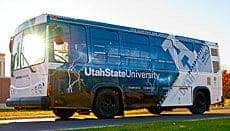
While the first electric public transport vehicle become operational more than a century ago when the first trolleys rolled on the streets of Europe’s capitals and America’s major cities, development towards autonomous electric public transportation hasn’t really developed that much since then. Sure power and efficiency has evolved tremendously, but the working principle is more or less the same. Recently, Utah State University unveiled something worth presenting to the world, after it released, through a spin-off company, the world’s first wirelessly charged electric bus.
When inductive charging was first introduced by Nikola Tesla, like most of his inventions that later become fundamental to human civilization, his work was labelled as unpracticle. Yet far from his brilliant vision of a wireless electrical grid that can transfer energy from point A to point B no matter the distance, recent technological advancements has made wireless charging a reality albeit over short distances.
Called the Aggie Bus, the all electric bus is based on Utah State University’s wireless power transfer system, publicly presented a mere 16 months before, which is capable of transferring enough energy to quickly charge an electric vehicle. Thus the Aggie Bus was fitted with an advanced prototype of the system that transfers power over an air gap where no physical contact is required. More specifically, the Aggie Bus is capable of a power level up to 25 kilowatts, greater than 90 percent efficiency from the power grid to the battery and a maximum misalignment of up to six inches.
“The unveiling of the Aggie Bus today is a historic achievement and a great leap forward in the science and engineering related to electric vehicles,” said Robert T. Behunin, USU vice president of commercialization and regional development. “As a result of the work done by Utah State engineers, scientists and partners, EV owners and operators will now be able to simply drive over a pad in the ground to recharge their batteries, the benefits of which reach far beyond convenience.”
“Current battery limitations prevent an all-electric transit bus from operating all day from an overnight charge,” said Wesley Smith, CEO of WAVE. “WAVE solves that problem by charging the bus wirelessly during its daily operations when the bus stops to load and off-load passengers. This technology makes electric buses competitive with their diesel hybrid and CNG counterparts.”
source: USU press release






